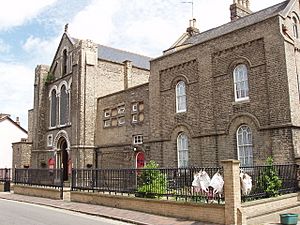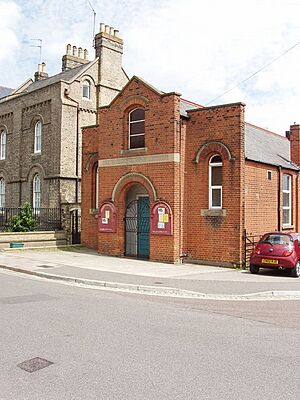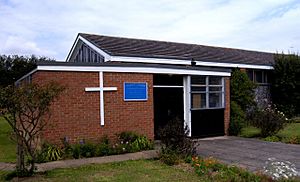St James the Less and St Helen Church, Colchester facts for kids
Quick facts for kids St James' Church |
|
|---|---|
| St James the Less and St Helen Church | |
 |
|
| Lua error in Module:Location_map at line 420: attempt to index field 'wikibase' (a nil value). | |
| OS grid reference | TM 00241 25198 |
| Location | Colchester, Essex |
| Country | England |
| Denomination | Roman Catholic |
| Website | StJamestheLessandStHelen.org |
| History | |
| Former name(s) | St James the Great Church St James the Less Church |
| Status | Parish church |
| Dedication | James the Less and Helena |
| Architecture | |
| Functional status | Active |
| Architect(s) | Joseph John Scoles |
| Style | Romanesque Revival |
| Groundbreaking | 3 March 1837 |
| Construction cost | £2,750 |
| Administration | |
| Deanery | Colchester |
| Diocese | Brentwood |
| Province | Westminster |
St James the Less and St Helen Church is a Roman Catholic church in Colchester, England. It is a Parish church, which means it serves a local community. The church was built in 1837. It was designed by an architect named Joseph John Scoles.
You can find the church on Priory Street in the city centre. It is located between East Hill and St Thomas More Catholic Primary School. Right next to the church is its hall. This hall was built later, in 1911, and designed by Joseph Scoles' son, Alexander Scoles.
Contents
The Story of St James' Church
How It All Began
In the late 1700s, some Roman Catholic people came to Colchester. Many were exiles, meaning they had to leave their home country during the French Revolution. Later, in the early 1800s, Irish Catholic soldiers were stationed in the town.
In 1814, a French priest, Father Amand Benard, started serving this community. He also helped the soldiers. A few years later, in 1831, a building was given to the local Catholic community. It was near North Hill. A priest from Witham would travel to Colchester to lead Mass there. Mass is the main worship service in the Catholic Church.
Building the Church
The land for the church we see today was a gift. It was donated by James Hoy, a farmer from Stoke-by-Nayland. The money to build the church came from Alfred Stourton, 23rd Baron Mowbray.
On March 3, 1837, an important ceremony took place. The first stone of the church was laid by Thomas Griffiths. He was a bishop from London. The total cost to build the church was £2,750.
The architect, Joseph John Scoles, designed the church in a style called Romanesque Revival. This style looks a bit like the old Roman buildings. It also reminded people of the nearby ruins of St Botolph's Priory. Joseph Scoles later used a similar design for another church in Islington.
When it was first built, the church was named after Saint James the Greater. It did not have any statues or images on the outside. This was to help avoid any problems with people in the town who were not Catholic.
Changes Over Time
In 1900, the church's name was changed to St James the Less. This was done to prevent confusion with another church nearby, the Anglican St James the Great Church. Just two years later, in 1902, the name changed again. It became St James the Less and St Helen. Saint Helen was believed by some local historians to have been born in Colchester.
During the Crimean War in the 1850s, many Catholic soldiers were in Colchester. They made up a large part of the church's congregation. In 1865, a special military chaplain was appointed for the soldiers. This chaplain used a chapel at the military camp starting in 1867.
By 1904, St James' Church became the main place of worship for the soldiers again. Later, in 1954, a new church was built specifically for the soldiers at the Colchester Garrison. This military church closed in the 1980s. Since then, army families attend Mass at St John the Baptist Church in Shrub End. This church is served by priests from St Teresa of Lisieux Church in Lexden.
In 1891, a group of nuns called the Sisters of Mercy came to the parish from Brentwood. They built a school right next to the church in 1896.
Expanding the Church
In 1861, the church needed more space for the growing number of soldiers attending. So, the church organ was moved from the gallery. From 1902 to 1932, a priest named Canon Bloomfield was in charge. He helped make the church bigger.
In 1904, a new section called the north aisle and a sacristy (a room where priests prepare) were added. Then, in 1907, the south aisle was built. The architect for these additions was Charles Edward Butcher. These improvements cost £2,000 and were paid for by Dean Lucas.
In 1911, the church hall was built next door. The architect was Canon Alexander Scoles, who was the son of the original church architect. The hall was opened by Cardinal Francis Bourne, a very important church leader. It was later renamed the Cardinal Bourne Institute.
In 1975, the inside of the church was rearranged. In 1987, beautiful stained-glass windows were added to the Blessed Sacrament chapel. These windows were originally designed by Augustus Pugin and came from another church that was no longer in use.
The Parish Community
St James' Church is the main church for several other Catholic churches nearby. These include St Cedd and St Gregory's Church in West Mersea, St Joseph's Church in Mile End, and St Theodore of Canterbury Church in Monkwick. Each of these churches has one Sunday Mass.
St James' Church itself has five Masses on Sundays. There is one on Saturday evening at 6:15pm. On Sunday, Masses are at 8:00am, 10:30am, 2:00pm (which is in Polish), and 6:30pm.
See also
- Roman Catholic Diocese of Brentwood



